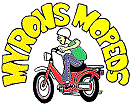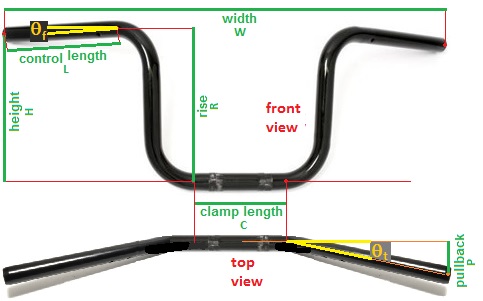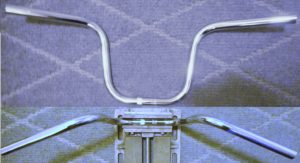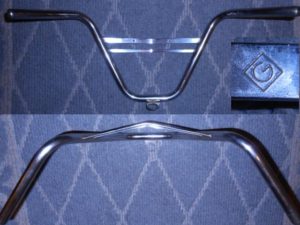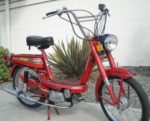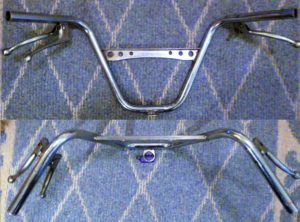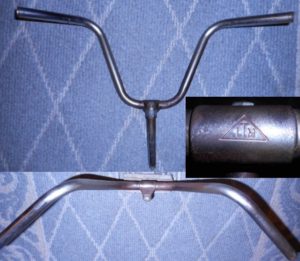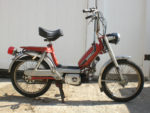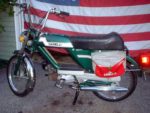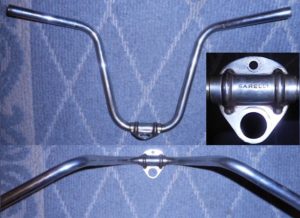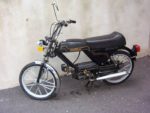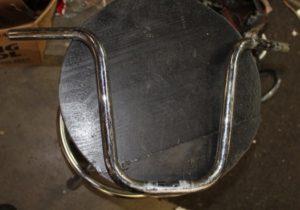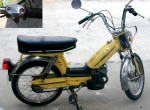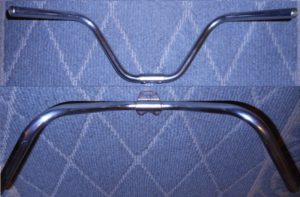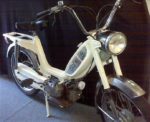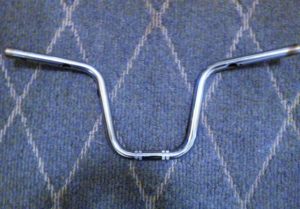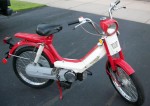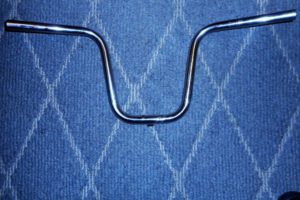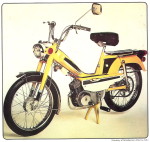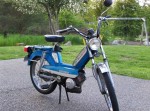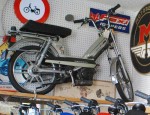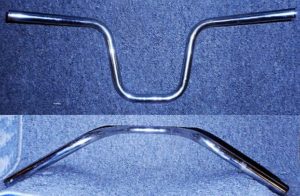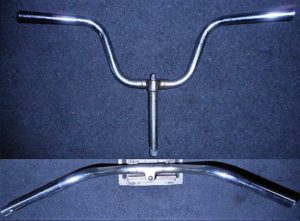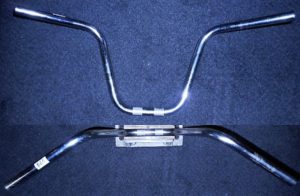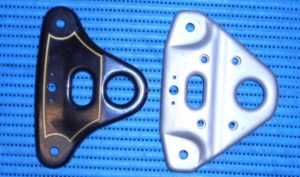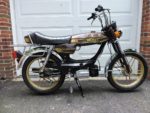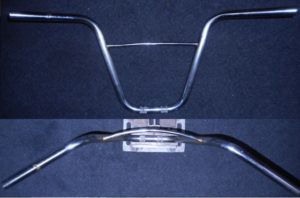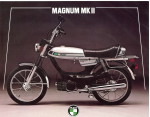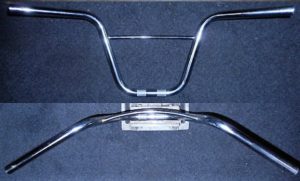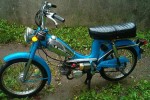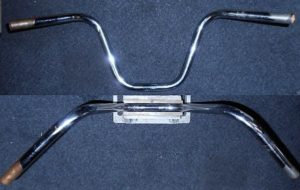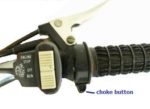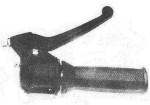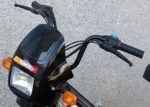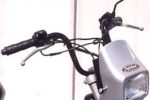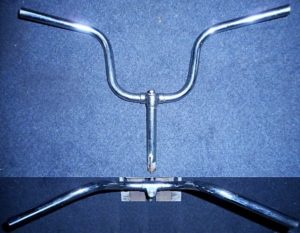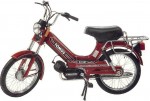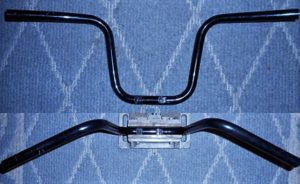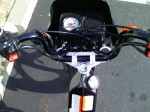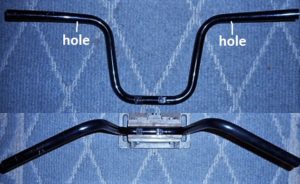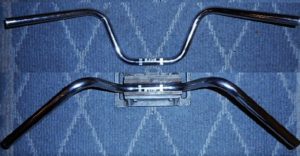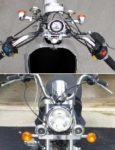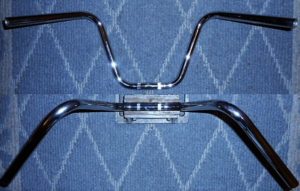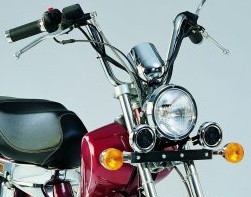Contents:
1. Handlebar Specifications
2. Aftermarket Handlebars
3. Original Handlebars
1. Handlebar Specifications
Natural angle: Close your eyes, clench your hands in a fist, relax, and put both arms forward and down a little. That is the natural position of your hands. They form an angle, called θf, viewed from the front, and another angle, called θt, viewed from the top. Handlebars are all close to the average natural position of human hands.
Positioning: Clamp-on handlebars can rotate in the clamps. During installation the rider chooses the best clamping position, for comfort and control. Most handlebars (except Clubman) are positioned with the rising part going straight up when viewed from the side. A rider with short arms might prefer a more rearward position, while a rider with long arms might want a more forward position.
Flipping (inverting): Any clamp-on handlebar can be flipped over (inverted). But most will feel wrong and strain the wrists. Of the handlebars shown below, only the Clubman and Drag bars can be flipped over, and still feel right.
Dimensions: Six lengths can completely describe a handlebar, without the need for angles. Here the side-view angle θs, and the top-view angle θt, are calculated from the lengths R, H, P, L, W, and C.
tan(θt) = 2*P / (W-C)
sin(θf) = (R-H) / L
Measuring: When measuring the dimensions, the end points are at the centers of the tubes, not the edges. The handlebar is placed on a flat table. With the rises vertical, the rise and height are measured from the center of the bar, straight down to the table, with 1/2 of the bar width subtracted (-0.4 inch). With the rises horizontal, the pullback is measured similarly.
Height: Looking from the front, most handlebars, especially low ones, slant down slightly going outward, at an angle θf, because the height is less than the rise. On some handlebars, the height is greater than the rise, and θf is negative.
Pullback: Looking at most motorcycle bars from the top, the bars slant rearward, at an angle θt, because the pullback is greater than zero. When the pullback is zero, θt becomes zero. Cruiser bars are for comfort and have a large pullback, where the bar ends point more towards the back of the bike. Drag bars are for high powered acceleration, and have a small pullback for control and grip.
2D or 3D: When the pullback is zero, the handlebar is 2-dimensional and will lay completely flat. Otherwise, most 4-bend (non-Drag) bars are 3D and do not lay flat on a table. 2D handlebars are simpler to make, but don’t feel “right”, except maybe at one particular position. 3D handlebars are more complicated to make, but will feel “right” in a range of positions.
Width: Wider handlebars allow better control. Off road bikes have wider bars. Narrow bars have less control, but are more aerodynamic for better fuel economy or higher top speed, and can squeeze through smaller spaces, like in between stopped cars.
Rise: High rise handlebars are taller, and put the hands higher. This can position the rider’s torso in a more upright position, for helping with back pain. Higher bars allow better control when standing up, like when jumping or hitting pot holes. Low rise handlebars put the rider leaning more forward. That reduces wind drag for higher top speed or better fuel efficiency.
Control length: Motorcycle handlebars need about 3 inches more control length than bicycle handlebars. They have thumb-operated levers or buttons, in addition to the finger-operated hand levers. Motorcycles have a twist throttle and a hydraulic brake on the right that takes up space. For motorcycles the minimum control length is roughly 8 inches. For mopeds it is about 6 inches. For bicycles it is about 5 inches. Any handlebar that has extra control length, can be cut shorter, up to the minimum control length, to reduce it’s width.
Clamp length: The center straight area needs to be at least as long as the clamps. Motorcycles have wider handlebar clamps than mopeds. Here is a table of moped handlebar clamp spacings:
xxxxxxxxx xx inner outer
Tomos A55 xx 1.7″ xx 3.1″ only this fork has enough inner space for bicycle bars with a 1″ x 1.7″ center bulge
Puch Maxi xx 1.55 xx 3.2
Hercules xxxx 1.2 xxx 2.4
Peugeot 103 x 1.2 xxx 2.3
Cimatti xxxx none xxx 2.4
Motobecane x 1.5 xxx 2.7
Applications: Not all mopeds can accept clamp-on “universal” handlebars. Some mopeds have bolt-on handlebars, where there are plates welded to the bar that bolt to the fork. Some mopeds have stem-mounted handlebars, where there is a long neck that goes inside the fork, held by a wedge bolt.
Thickness: Most modern 7/8 handlebars are 0.875 inch = 22.2 mm.
Vintage metric handlebars, are 0.863 to 0.866 inch = 21.9 to 22.0 mm.
The dual standard can sometimes cause problems.
22.0 controls on 22.2 bars: Wedge type controls, such as Domino, for 22.0 bars cannot fit on 22.2 bars. Wedge type controls do not clamp, but instead press a cone into the bottom of the handlebar. 1960’s, 70’s and 80’s “vintage” Domino controls have a fixed size hole, 22.0 mm, for 21.9 bars.
22.2 controls on 22.0 bars: Original vintage handlebars 22.0, with 1970’s Magura clamp type controls, require a strip of aluminum can under the clamp, to hold solid onto the handlebar. Otherwise the throttle slips around the bar. 1990’s and 2000’s “modern” Domino wedge type controls have a 22.3 mm hole, that works fine on either modern 22.2 or vintage 22.0 bars.
2. Aftermarket Handlebars
width 26
height 8.5
rise 7.5
clamp length 4.0
control length 6.5
pull back 4.0
Stock Moped chrome $25 thickness 0.872″ (22.14)
Fits clamp type (22.6) controls and modern wedge type (22.3) controls.
Fits some vintage wedge type (22.0) controls, but some need sanding.
The width cannot be reduced by cutting
because the control length is already short, 6.5″.

This has a 1 by 1.7″ center bulge.
Because of that, it only fits 08-17
Tomos or bikes with that fork.
width 20.3
height 5.0
rise 4.8
clamp length 3.5
control length 6.0
pull back 2.5
Wald 3346 chrome $15
thickness 7/8″ 0.0876 (22.3)
Only fits clamp type (22.6) controls
and modern wedge type (22.3) controls.
This is the only 7/8″ handlebar offered
here that is truly 7/8 = 0.875 inch,
because it’s American made.
3. Original Handlebars
Most Original Equipment Manufacturer (OEM) handlebars are available in a range of conditions. All are straight, unless noted. Some are new, some good used, and some are pitted, peeling or scratched. Some have tiny scuffs from being jostled around in parts bins. They are priced accordingly. Photos of actual choices are available, by email.
Dual standards: Vintage European original bicycle and moped handlebars are 21.9 to 22.0 mm, to fit 22.0 controls. This metric standard lasted until the 1980’s. After the 80’s most European handlebars became 22.3 mm = 7/8 inch.
Cimatti
Cimatti 3110
$20-$45 good used
thick 0.862 (21.9mm)
width 24
height 9.6
rise 9.3
pull back 6.5
clamp length 3.0
control length 6.2
These bars have a plate and a clamp. The clamp has the strength to hold the bar, while the plate keeps it in that one position. The clamp will still hold if the plate is cut off. Without the plate the bar position is adjustable. Curiously this Cimatti handlebar is made by Garelli. See the tilted G logo?
Cimatti 2940 bars with levers
$70 very good used
thick 0.862″ (21.9 mm)
width 23
height 9.5
rise 10.0
clamp length 3.5
pull back 7.3
control length 6.2
Garelli
Garelli 1975-79 bars-with-stem
500.204.5100 $35 rusted (shown)
thick 0.862 (21.9 mm)
width 22.5
height 7.9 plus stem
rise 8.3 plus stem
clamp length —
control length 5.8
pull back 5.1
These bars are on 1975-79 Garelli mopeds. They can adjust up and down, by how far the stem is inserted.
Garelli 1977-79 high bars-with-stem
none available
thick 0.862 (21.9 mm)
width 23?
height
rise
clamp length —
control length 5.8?
pull back
These bars are on 1977-78 Garelli Supersport XL and others.
Garelli 1978-79 bars-with-plate
none available
thick 0.862 (21.9 mm)
width 23,
height 11.1
rise 10.2
clamp length —
control length 5.7
pull back 3.6
These bars are on certain 1978-79 models. The bottom of the handlebar has a chrome steel plate that says Garelli. The chrome handlebar plate bolts to the painted fork top plate. The fork top plate is made of stamped sheet steel. For these bolt-on bars the fork top plate was made too thin, causing most to crack near the edges of the handlebar plate. Garelli soon realized this problem, and stopped making the bars-with-plate design in 1979.
Garelli 1978-86 clamp-on bars
507643.5100 none available
thick 0.862 (21.9 mm)
width
height
rise
clamp length
control length
pull back
These bars are on most 1980-86 Garelli, US models, and 1978-79 VIP and LTD (mag wheel) deluxe models. For about one year in 1978-79 all three handlebar designs were on Garelli mopeds, handlebar-with-stem, handlebar-with-plate, and clamp-on handlebar. But by 1980, all models had the clamp-on handlebar design, with strengthened fork top plate that did not crack easily.
Gitane
Gitane (Testi) bars-with-plate
052181 $40 good used (shown)
thickness ∼7/8″ 0.862″ 21.9 mm
width 23.5
height 5.4
rise 6.6
clamp length —
control length 6.2
pull back 6.5
The 1977-80 Gitane mopeds (US models, made by Testi) had this bolt-on handlebar.
Honda
Honda PA50
$50 (shown)
thick 0.862 (21.9 mm)
width 23.5
height 9.5
rise 8.3
clamp length 3.5
control length 6.0
pull back 3.0
These clamp-on bars have large holes for the electrical wires to go inside the handlebar. They have small holes for the little pins that hold the controls in a fixed position. They also have rubber-grommet covered holes for the throttle and choke or decomp cable. So altogether there are 7 holes.
Kreidler
Kreidler bars
xxx thickness ∼7/8″ 0.862″ 21.9 mm
xxxxxxx width 24″
xxxxxx height 8.7
xxxxxxxx rise 8.8
xclamp length 3.2
control length 6.3
xxxx pull back 3.5
These clamp-on bars are on Kreidler Flory MP9 and MP19 mopeds. The handlebar has a short tab under the center, that fits into a slot in the fork top plate.
Motobecane
Motobecane 50V bars
xxx thickness ∼7/8″ 0.862″ 21.9 mm
xxxxxxx width 21.5
xxxxxx height 6.3
xxxxxxxx rise 6.2
xclamp length 3.5
control length 5.5
xxxx pull back 4.6
These bars are on 1975-1980 Motobecane mopeds, US models 7, 40, 50, 50V, Moby, Le Moped.
Peugeot
Peugeot 103LVS bars
xxx thickness ∼7/8″ 0.862″ 21.9 mm
xxxxxxx width
xxxxxx height
xxxxxxxx rise
xclamp length
control length
xxxx pull back
These bars are on Peugeot 103LS and 103LVS models. They are so scarce that no sample was available for a photo and measurement.
Peugeot 103SP bars
xxx thickness ∼7/8″ 0.862″ 21.9 mm
xxxxxxx width 22.3
xxxxxx height 7.5
xxxxxxxx rise 7.0
xclamp length 2.8
control length 6.5
xxxx pull back 4.2
These bars are on 102SP and 103SP models. They have thin wall tubing, for light weight, but they bend easily. So unbent originals are scarce.
Puch
Puch 1969-77 bars-with-stem
xxx thickness ∼7/8″ 0.862″ (21.9mm)
xxxxxxx width 23″
xxxxxx height 6.0 plus stem
xxxxxxxx rise 6.0 plus stem
xclamp length —-
control length 5.5
xxxx pull back 2.8
These bars are on early Puch Maxi models, 1969 to 1977. The height is adjustable by the position of the stem.
Puch 1977-86 bars
xxx thickness ∼7/8″ 0.862″ (21.9mm)
xxxxxxx width 24.2″
xxxxxx height 8.8
xxxxxxxx rise 8.6
xclamp length 3.5
control length 6.0
xxxx pull back 4.3
These clamp-on bars are on 1978-79 Maxi Luxe, Newport, Maxi II, and 1980-86 Maxi, Maxi Luxe, Newport II.
1. $25 straight, clean, but pitted
2. $25 straight, clean, but pitted
3. $25 straight, clean, but pitted
4. $10 straight, badly pitted
5. $20 straight, clean, pitted
6. $20 straight, clean, pitted
7. $10 straight, badly pitted
8. $15 straight, but pitted
9. $45 straight, nice, some pitting
10. $50 straight, almost no pitting
11. $60 straight, no pitting, like new
12. $25 straight, dark blue sparkle
Puch tall bars
xxx thickness ∼7/8″ 0.866″ 22.0 mm
xxxxxxx width 25.7
xxxxxx height 10.6
xxxxxxxx rise 10.3
xclamp length 3.5
control length 6.0
xxxx pull back 4.1
These bars are the same as Maxi bars but taller. They are on 1977-78 Sport, Sport MkII, and 1984-86 Maxi, Maxi Sport LS, Maxi Sport LS 2. They are heavy because of thick wall tubing.
Puch tall cross bars
xxx thickness ∼7/8″ 0.862″ (21.9mm)
xxxxxxx width 25.7
xxxxxx height 10.6
xxxxxxxx rise 10.3
xclamp length 3.5
control length 6.0
xxxx pull back 4.5
These bars are the same as tall bars, but have a curved crossbar. They are on 1979-86 Sport, Sport MkII and 1980 Magnum II.
Puch low cross bars
xxx thickness ∼7/8″ 0.862″ (21.9mm)
xxxxxxx width 25″
xxxxxx height 8.6
xxxxxxxx rise 8.4
xclamp length 3.5
control length 6.0
xxxx pull back 4.3
These bars are similar to Maxi bars, but shorter and with a curved crossbar. They are on 1978-79 Magnum XK, Magnum MkII.
Sparta
Sparta bars
xxx thickness ∼7/8″ 0.871″ (22.1mm)
xxxxxxx width 22.8
xxxxxx height 6.3
xxxxxxxx rise 7.3
xclamp length 3.5
control length 6.0
xxxx pull back 5.6
There are several mopeds with these handlebars: Sparta Foxi GT, Sparta Buddy, Sparta Lucky, Sparta Flying Dutchman, and others. These bars are the same as Batavus VA, Batavus Starflite, Batavus Regency bars, but with more pullback. They are made in Holland with high quality chrome that resists rusting.
Tomos
< These Tomos controls do not have a post, so the handlebar does not need holes.
< These Tomos controls have a post that goes into a hole in the handlebar. When changing handlebars, holes have to be drilled. The holes have to be in a particular place to make the levers the same, and at the correct angle.
Tomos 1974-1979 bars-with-stem
xxx thickness ∼7/8″ 0.867″ (22.0mm)
xxxxxxx width 23.4
xxxxxx height 7.0
xxxxxxxx rise 6.8
xclamp length —-
control length 6.0
xxxx pull back 3.2
This stem type handlebar is what bicycles have. Older mopeds were more like bicycles. The stem can be positioned to make the bars higher or lower.
Tomos 1979-1991 bars
xxx thickness ∼7/8″ 0.867″ (22.0mm)
xxxxxxx width 24.3
xxxxxx height 7.6
xxxxxxxx rise 7.0
xclamp length 3.5
control length 6.5
xxxx pull back 3.8
Tomos 1985-2008 bars
xxx thickness ∼7/8″ 0.0875″ (22.2mm)
xxxxxx width 24″
xxxxxx height 7.5
xxxxxxxx rise 7.9
xclamp length 4.0
control length 6.0
xxxx pull back 3.7
These bars do not have the holes for 2008-13 controls.
Tomos 2008-2013 bars
xxx thickness ∼7/8″ 0.0875″ (22.2mm)
xxxxxx width 24″
xxxxxx height 7.5
xxxxxxxx rise 7.9
xclamp length 4.0
control length 6.0
xxxx pull back 3.7
These bars have the holes for late-model Domino or TBS controls.
Tomos Streetmate bars
xxx thickness ∼7/8″ 0.0872″ (22.2mm)
xxxxxx width 26.2″
xxxxxx height 4.2
xxxxxxxx rise 5.6
xclamp length 4.3
control length 7.7
xxxx pull back 5.7
These have holes for late Domino or TBS controls.
Tomos Revival bars
xxx thickness ∼7/8″ 0.0872″ (22.2mm)
xxxxxx width 25.0″
xxxxxx height 6.6
xxxxxxxx rise 8.1
xclamp length 4.3
control length 7.5
xxxx pull back 6.7
These have holes for late Domino or TBS controls.
